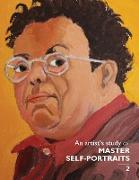- Start
- An artist's study of MASTER SELF-PORTRAITS 2
An artist's study of MASTER SELF-PORTRAITS 2
Angebote / Angebote:
As I said in my first self-portraits book, copying master self-portraits gives the young or amateurish painter the illusion of knowing and painting like the masters themselves. It doesn't matter if the result in each case is superficial and plagiaristic. It gets the copier closer to the subjects copied and is a delightfully pleasant exercise. It may even improve the copier's technical ability.
In a general sense, merely looking at master painters' self portraits is like meeting the masters. If the viewer is also copying the works it is like painting along side the master in the master's own studio or workplace.
The first two self-portraits in this book are of Giotto and Benozzo Gozzoli, both borin in Florence, Italy, respectively in 1267 and 1420. At that time and place there was no such thing as a studio self-portrait. Most wall paintings were al fresco, done in churches or palaces and mostly Biblical subjects. Artists such as Giotto and Gozzoli painted themselves, if at all, in a crowd or procession. Later, as secular subjects dominated European art, Durer, Holbein and Rembrandt, among others, created or nourished a practice of self-portraiture that exists and continues to evolve today.
Leonardo never painted a self-portrait, but his red charcoal drawing is included in this collection in homae to the greatest painter ever. Self-portraits reveal much about the artist. Caravaggio, for example, led a rough, violent life and he portrayed himself as the severed head of Goliath. Raphael reveals in his modest self-portrait his renowned sweetness. Courbet, a bold, dramatic character, portrays himself in a greatly agitated state. Henri Rousseau, perhaps the greatest self-taught, naive artist, portrays himself in a grand, dignified manner. Klimt, who painted the most beautiful or brilliantly adorned women never painted his own portrait, saying, "I am less interested in myself as a subject for a painting than I am in other people, above all women." So, Klimt is represented in this collection not by a self-portrait but by a portrait of him by Swiss painter, Ferdinand Hodler. Frida Kahlo painted a great many self-portraits in a wide variety of settings and poses suggesting, perhaps, the turmoil in her own life.
-Thomas Crawford
Folgt in ca. 10 Arbeitstagen
